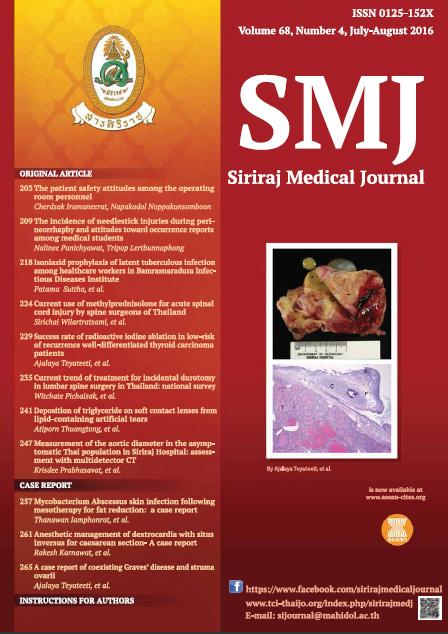Success Rate of Radioactive Iodine Ablation in Low-Risk of Recurrence Well-Differentiated Thyroid Carcinoma Patients
Keywords:
Well-differentiated thyroid cancer, low risk of recurrence, radioactive iodine ablationAbstract
Objective: To evaluate success rate and factors affecting the success of radioactive iodine (RAI) ablation in low-risk of recurrence well-differentiated thyroid carcinoma patients.
Methods: Retrospective review of medical records was done in 132 low-risk of recurrence well-differentiated thyroid cancer (WDTC) patients between January 2007 and December 2013. All patients underwent 1) total thyroidectomy or equal surgery and 2) pre-ablative evaluationwith 99mTc-pertechnetate thyroid scan and 24-hour 131I thyroid uptake. RAIablation using low activity (30 mCi: n = 17) or high activity (80 or 100 mCi: n = 115) were given. Success rate of each activity and a comparison of success rates between 2 doses were analyzed. Criteria of successful ablation were composed of 1) no palpable neck mass 2) no demonstrable thyroid and tumor uptake on the follow up 6-12 months diagnostic whole body scan (WBS) and 3) stimulated thyroglobulin (Tg) lower than 2 ng/mL in the absence of interfering thyroglobulin antibodies (TgAb <40 IU/mL). Factors that may affect success of radioactive iodine ablation were studied; age, gender, tumor size, stage, pathological result, number of lesions, pre-ablation 24-hour 131I thyroid uptake, serum T4, TSH, Tg and TgAb at time of ablation.
Results: Overall success rate of RAI ablation was achieved in 95 patients out of 132 patients (72%). Low and high dose RAI ablation were completed in 9/17 patients (52.9%) and in 86/115 patients (74.8%), respectively (p-value = 0.082). Baseline Tg at time of ablation was a factor related to the success of ablation. Median Tg in success and failure group was 2.61 and 7.18 ng/mL, respectively (p = 0.023).
Conclusion: Success of 131I ablation in low-risk of recurrence well-differentiated thyroid cancer patients was 72%. The factor relating to ablative success was Tg level at time of ablation.
Downloads
Published
How to Cite
Issue
Section
License
Authors who publish with this journal agree to the following conditions:
Copyright Transfer
In submitting a manuscript, the authors acknowledge that the work will become the copyrighted property of Siriraj Medical Journal upon publication.
License
Articles are licensed under a Creative Commons Attribution-NonCommercial-NoDerivatives 4.0 International License (CC BY-NC-ND 4.0). This license allows for the sharing of the work for non-commercial purposes with proper attribution to the authors and the journal. However, it does not permit modifications or the creation of derivative works.
Sharing and Access
Authors are encouraged to share their article on their personal or institutional websites and through other non-commercial platforms. Doing so can increase readership and citations.










